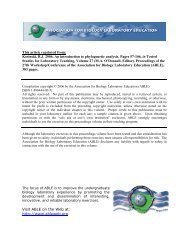New Light on Phototaxis and Phototropism - Association for Biology ...
New Light on Phototaxis and Phototropism - Association for Biology ...
New Light on Phototaxis and Phototropism - Association for Biology ...
You also want an ePaper? Increase the reach of your titles
YUMPU automatically turns print PDFs into web optimized ePapers that Google loves.
Volume 25: Mini Workshops 401<br />
easy access <strong>for</strong> delivering the light stimulus <strong>and</strong> <strong>for</strong> viewing by the experimenter. A small, inverted<br />
cardboard box, with appropriate cut-outs in the sides, often suffices as a canopy. [NOTE: It may<br />
take several minutes of exposure to darkness <strong>for</strong> an animal to become dark-adapted <strong>and</strong> <strong>for</strong> its<br />
resp<strong>on</strong>ses to light to become accentuated. Patience <strong>and</strong> time are often needed to obtain clear-cut<br />
resp<strong>on</strong>ses.]<br />
(2) In some cases, such as newly hatched brine shrimp or daphnids, it works well to study<br />
phototaxic resp<strong>on</strong>ses to numerous organisms at <strong>on</strong>ce rather than individual organisms. A dozen or<br />
more of these animals may be placed in a relatively c<strong>on</strong>fined space, such as a shallow petri dish of<br />
water, with the LED light source placed somewhat horiz<strong>on</strong>tally at the side of the c<strong>on</strong>tainer, rather<br />
than shining down from above. To enhance c<strong>on</strong>trast, it may be helpful to place a piece of paper<br />
(light-colored <strong>for</strong> daphnids or dark-colored <strong>for</strong> brine shrimp) under the transparent bottom of a<br />
c<strong>on</strong>tainer, such as a petri dish. Then, studies <strong>and</strong> comparis<strong>on</strong>s of the directi<strong>on</strong> of swimming <strong>and</strong><br />
overall locati<strong>on</strong> of animals may be made at two different times: (a) immediately be<strong>for</strong>e the LED is<br />
turned <strong>on</strong> at side of the dish, <strong>and</strong> (b) about 15 sec<strong>on</strong>ds after the light has been turned <strong>on</strong> (Fig 2).<br />
(3) Some aquatic organisms, especially daphnids, tend to periodically cease swimming <strong>and</strong><br />
momentarily cling to the sides or bottom of their c<strong>on</strong>tainer. Under these circumstances, locomotor<br />
movements toward or away from a light source may not occur. In such cases, it may be necessary to<br />
gently vibrate the c<strong>on</strong>tainer, thus stimulating the organisms to release their attachment <strong>and</strong> begin<br />
swimming movements that are oriented toward or away from the LED source (Fig. 2).<br />
(4) Resp<strong>on</strong>ses to LED-stimulati<strong>on</strong> in creeping <strong>and</strong> crawling organisms such as flatworms,<br />
earthworms, or aquatic oligochaetes (e.g., Lumbriculus variegatus) are likely to involve a<br />
combinati<strong>on</strong> of both negative phototaxis <strong>and</strong> photokinesis resp<strong>on</strong>ses. Such resp<strong>on</strong>ses may be studied<br />
by placing <strong>on</strong>e worm into a narrow, linear-shaped c<strong>on</strong>tainer that has straight sides, covered<br />
transparent top, <strong>and</strong> transparent bottom. “Flexible foam-well slides” made from foam tape are<br />
especially useful <strong>for</strong> this purpose [see: http://www.eeob.iastate.edu/faculty/DrewesC/htdocs/].<br />
Alternatively, worms may be placed in culture tubes with flat tips<br />
or glass capillary tubes<br />
. With a worm c<strong>on</strong>fined to<br />
this narrow, linear space, study its reacti<strong>on</strong>s <strong>and</strong> locomotor movements toward or away from a<br />
bright, c<strong>on</strong>stant light positi<strong>on</strong>ed at the worm’s head or tail end.<br />
(5) Keep in mind that in order <strong>for</strong> an animal to produce a phototaxic resp<strong>on</strong>se in relati<strong>on</strong> to a<br />
gradient of light, the animal must somehow be able to sense, <strong>and</strong> resp<strong>on</strong>d to, small differences in<br />
light intensity that exist within its immediate envir<strong>on</strong>ment. To do this, the animal needs <strong>on</strong>e or more<br />
photoreceptor cells in its body. In theory, if an animal has <strong>on</strong>ly a single photoreceptor cell, then in<br />
order <strong>for</strong> it to produce a phototaxic resp<strong>on</strong>se within a light gradient, it would be necessary <strong>for</strong> the<br />
animal to be moving. Such movement is needed to allow the animal to “detect <strong>and</strong> compare the light<br />
intensity reaching its photoreceptor” at two different times – initially, when its body is in <strong>on</strong>e<br />
specific positi<strong>on</strong> <strong>and</strong> then, a short time later, when its body is in a somewhat different positi<strong>on</strong><br />
within the light gradient. Given sensory in<strong>for</strong>mati<strong>on</strong> about the comparative intensity of illuminati<strong>on</strong><br />
at these two different locati<strong>on</strong>s, the animal may then appropriately resp<strong>on</strong>d by turning <strong>and</strong> moving<br />
toward (or away from) the directi<strong>on</strong> in which the light was most intense. If the animal has more than<br />
<strong>on</strong>e photoreceptor cell then, in theory, it is possible <strong>for</strong> it to sense the directi<strong>on</strong> of the light gradient<br />
even if it is not moving. This is possible if the animal is able to simultaneously detect <strong>and</strong> compare<br />
the intensity of light striking two or more photoreceptors that are necessarily localized in different<br />
parts of its body <strong>and</strong> receiving different levels of light intensity. In invertebrates with two or more<br />
photoreceptors, it is likely that a combinati<strong>on</strong> of both of these detecti<strong>on</strong> <strong>and</strong> comparis<strong>on</strong> strategies is<br />
probably used. That is, the organism may make sequential comparis<strong>on</strong>s of intensity using the same<br />
Associati<strong>on</strong> <strong>for</strong> <strong>Biology</strong> Laboratory Educati<strong>on</strong> (ABLE) ~ http://www.zoo.utor<strong>on</strong>to.ca/able
















